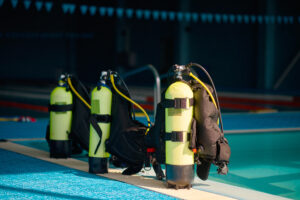What is a Purge?
In scuba diving, the term “purge” refers to the mechanism used to expel water from certain pieces of diving equipment, primarily diving masks and regulators. The ability to quickly and efficiently remove water from these components is crucial for ensuring clear vision and unimpeded breathing underwater. The concept of purging has evolved significantly over the years, becoming an integral part of modern scuba gear. Understanding the function and proper use of purge systems is essential for divers at all levels, as it directly impacts safety and comfort during underwater excursions.
Historical Development of Purge Mechanisms
The development of purge mechanisms in scuba equipment marks a significant advancement in diving technology. Early diving masks and regulators did not have dedicated purge features, which often made dealing with water intrusion a cumbersome task. Divers had to rely on less efficient methods to clear water from their masks and regulators, which could be time-consuming and sometimes unsafe in critical situations.
The introduction of purge valves in the mid-20th century brought a revolution to scuba diving gear. Initially, these valves were simple in design, allowing divers to expel water by exhaling forcefully through the mask or regulator. The first purge valves in diving masks appeared around the 1950s, offering divers a much-needed solution to the persistent problem of water ingress. These early models, though rudimentary, laid the foundation for more sophisticated designs.
As the sport of scuba diving grew in popularity, so did the demand for more reliable and user-friendly equipment. This led to significant innovations in purge technology. Manufacturers began to incorporate more advanced materials and engineering techniques, resulting in the highly effective purge systems we see today. Modern purge valves are designed to minimize the effort required by the diver, enhancing safety and overall diving experience. The evolution of these systems reflects the broader trends in diving technology, emphasizing improved functionality, safety, and user convenience.
Types of Purge Systems in Scuba Diving
Purge systems in scuba diving equipment come in various forms, each tailored to specific components of the diving gear. Two primary types of purge systems are commonly used: purge valves in diving masks and purge buttons in regulators. Understanding the differences and functionalities of these systems is key to making informed choices about diving equipment.
Purge Valves in Diving Masks
Diving masks equipped with purge valves provide an efficient way to clear water that may enter the mask. These valves are typically located at the bottom of the mask, allowing water to be expelled through a simple exhalation. When a diver exhales through their nose, the pressure forces the water out through the valve, leaving the mask clear and dry. This feature is particularly beneficial during descents or in rough waters where mask flooding can occur frequently.
The benefits of having a purge valve in a diving mask are numerous. It significantly reduces the time and effort required to clear the mask, enabling divers to maintain focus on their surroundings rather than struggling with equipment. This is especially important in situations where visibility is crucial, such as underwater photography or navigating through complex environments. Furthermore, purge valves enhance safety by minimizing the risk of prolonged exposure to water in the mask, which can cause discomfort and distraction.
Purge Buttons in Regulators
Regulators with purge buttons are another critical component of scuba gear that utilizes purge technology. These buttons are designed to clear water from the regulator’s second stage, ensuring that the diver can breathe without obstruction. When pressed, the purge button releases a burst of air through the regulator, expelling any water that may have entered. This mechanism is straightforward and highly effective, providing an immediate solution to water intrusion.
The functionality of purge buttons in regulators is particularly valuable in emergency situations or when dealing with equipment malfunctions. For example, if a diver accidentally removes their regulator from their mouth, water can enter the second stage. A quick press of the purge button clears the water, allowing the diver to resume breathing normally. Comparing this to non-purge regulators, the added safety and convenience of purge buttons are evident, making them a preferred choice for many divers.
Technical Specifications of Purge Mechanisms
The design and materials used in purge mechanisms are crucial for their effectiveness and durability. Purge valves and buttons are typically made from high-quality, corrosion-resistant materials such as silicone and marine-grade stainless steel. These materials are chosen for their ability to withstand the harsh underwater environment, including exposure to saltwater and varying pressures.
Design considerations for purge systems focus on ease of use and reliability. For instance, the placement of purge valves in masks is carefully chosen to ensure that water can be expelled with minimal effort. Valves are usually positioned at the lowest point of the mask, where water naturally collects. This strategic placement, combined with a one-way valve design, ensures efficient water expulsion with each exhalation.
Similarly, purge buttons in regulators are designed for quick and easy operation. They are typically large enough to be easily pressed, even with gloved hands, and positioned in a location that is easily accessible during a dive. The internal mechanism of the purge button must be robust and responsive, providing an immediate and powerful burst of air to clear water from the second stage. Regular maintenance of these components is essential to ensure they remain in optimal working condition. Divers are advised to routinely check their purge systems for signs of wear and tear, such as cracks in silicone valves or corrosion in metal parts, and to replace any damaged components promptly.
Purge Systems in Practice
Using purge systems effectively requires a good understanding of their operation and practical application during dives. Divers should become familiar with the steps to use purge valves and buttons to ensure they can respond swiftly and confidently when needed.
For diving masks with purge valves, the process is straightforward. If water enters the mask, the diver should look down and exhale through their nose. The exhaled air will push the water out through the valve, clearing the mask. This technique can be practiced on the surface before submerging to build confidence. Common issues that divers might face include improper fit or seal of the mask, which can cause persistent flooding. Ensuring a proper fit and adjusting the mask straps can help mitigate this problem.
Using purge buttons in regulators involves pressing the button to release a burst of air and clear any water from the second stage. This should be done calmly to avoid panic and to ensure the regulator remains in the mouth during the process. In cases where the regulator is removed, the diver should first secure it in their mouth, then press the purge button to clear the water before taking a breath. Troubleshooting common issues with purge buttons includes checking for blockages or debris that might impede the function and ensuring the button mechanism moves freely.
Purge systems are particularly beneficial in certain diving scenarios, such as when dealing with strong currents or performing underwater tasks that require frequent head movement. They allow divers to quickly clear their equipment and maintain visibility and breathing efficiency. This is essential for maintaining focus and ensuring safety during complex or prolonged dives.
Innovations and Future Trends
The field of purge technology in scuba diving continues to evolve, driven by advancements in materials science and engineering. Recent innovations include the development of more durable and efficient purge valves and buttons, incorporating features such as self-sealing designs and enhanced resistance to wear and tear.
Emerging trends in purge systems focus on improving user experience and safety. For example, some new designs feature integrated purge mechanisms that are more streamlined and reduce the likelihood of accidental activation. There is also ongoing research into materials that offer better performance under extreme conditions, such as deep dives or cold water environments.
Looking ahead, the future of purge systems in scuba diving is likely to see further integration with advanced diving technologies. This could include smart regulators with automated purge functions or enhanced feedback systems that alert divers to potential issues with their equipment. These innovations aim to make diving safer and more enjoyable, reflecting the continuous commitment of the diving industry to meet the needs of divers worldwide.
Importance of Purge Systems in Diver Safety and Comfort
Purge systems play a vital role in enhancing diver safety and comfort. By allowing quick and efficient clearing of water from masks and regulators, these systems reduce the risk of prolonged exposure to water, which can cause discomfort and impair vision. This is particularly important in challenging conditions where maintaining clear vision is critical for navigation and communication.
The safety benefits of purge systems are well-documented. For instance, in an emergency where a diver needs to clear their regulator quickly, the ability to purge water effectively can prevent panic and ensure a steady supply of breathable air. This capability is crucial for maintaining composure and safety in potentially life-threatening situations.
Comfort is another significant advantage provided by purge systems. Divers can focus more on their underwater experience and less on managing their equipment. This is especially beneficial during long dives or when performing tasks that require precise movements and concentration. The convenience of being able to quickly clear a mask or regulator enhances overall diving enjoyment and reduces the physical strain associated with managing equipment issues.
Statistical data and anecdotal evidence from divers underscore the effectiveness of purge systems. Many divers report feeling more confident and secure when using equipment with reliable purge mechanisms. This confidence translates into a more relaxed and enjoyable diving experience, which is essential for both novice and experienced divers.
Key Takeaways
The introduction and evolution of purge systems in scuba diving equipment have significantly enhanced safety and comfort for divers. From their historical development to the various types of purge mechanisms available today, these systems play a crucial role in ensuring clear vision and unobstructed breathing underwater. Innovations in purge technology continue to improve their effectiveness and ease of use, reflecting the diving industry’s commitment to advancing diver safety and experience. Understanding the functionality and proper use of purge systems is essential for all divers, contributing to safer and more enjoyable underwater adventures.

















